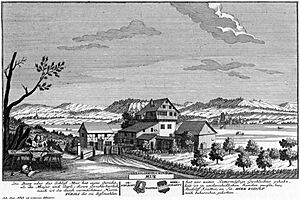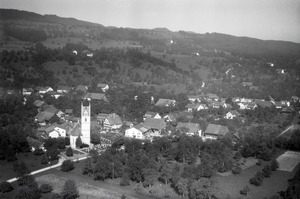Maur, Switzerland facts for kids
Quick facts for kids
Maur
|
||
|---|---|---|
 |
||
|
||
| Country | Switzerland | |
| Canton | Zurich | |
| District | Uster | |
| Area | ||
| • Total | 14.77 km2 (5.70 sq mi) | |
| Elevation | 478 m (1,568 ft) | |
| Population
(Dec 2020 )
|
||
| • Total | 10,780 | |
| • Density | 729.9/km2 (1,890.3/sq mi) | |
| Postal code |
8124
|
|
| Surrounded by | Egg, Fällanden, Greifensee, Herrliberg, Küsnacht, Mönchaltorf, Uster, Zollikon, Zumikon, Zurich | |
Maur is a small town, also called a municipality, in the Uster area of the canton of Zürich in Switzerland. It's a lovely place located near a lake.
Contents
History of Maur
Maur is a very old place. It was first written about between the years 874 and 887. Back then, it was known as de Mure.
Geography and Nature
Maur covers an area of about 14.8 square kilometers (5.7 square miles). A big part of this land, about 52.6%, is used for farming. Forests cover another 26.9% of the area. The rest of the land, about 20.2%, has buildings and roads. Only a tiny bit, 0.3%, is made up of non-productive areas like rivers.
The town is located on the southwest side of the Greifensee lake. Maur includes the main village and smaller areas like Aesch, Scheuren, Binz, Ebmatingen, and Uessikon.
Economy and Work
Maur is famous for the Powerplay studio. Many well-known Swiss musicians and international bands have recorded their hit songs there. Some famous names include the Bee Gees, Europe (who sang "The Final Countdown"), Lady Gaga, Lenny Kravitz, Prince, Snoop Dogg, and Wu-Tang Clan.
For a long time, Maur was not connected to big roads or railways. This meant that large factories or industries couldn't easily set up there. Even today, farming is still an important job for many people. There are also many small businesses that offer services or crafts.
Most people who live in Maur, about four out of five, work outside the town. They often travel to the city of Zurich or other nearby towns for their jobs.
People and Education
In 2007, Maur had a population of 9,119 people. About 17% of these people were from other countries. The population has been growing steadily over the last 10 years.
Most people in Maur speak German, which is about 86.4% of the population. English is the second most common language, spoken by 3.6%, followed by French at 2.1%.
Swiss people are generally well-educated. In Maur, about 88.3% of adults (aged 25-64) have finished high school or gone on to higher education, like university.
In 2005, about 147 people worked in farming. Another 389 people worked in manufacturing and construction. The largest group, 1411 people, worked in service jobs like shops, offices, and healthcare.
In 2008, there were about 2206 Catholics and 3997 Protestants living in Maur.
Historical Population Numbers
Here's how the population of Maur has changed over time:
| year | population |
|---|---|
| 1798 | 1,623 |
| 1836 | 2,133 |
| 1850 | 1,965 |
| 1900 | 1,513 |
| 1910 | 1,421 |
| 1950 | 1,577 |
| 1970 | 3,943 |
| 2000 | 8,677 |
See also
 In Spanish: Maur (Zúrich) para niños
In Spanish: Maur (Zúrich) para niños






